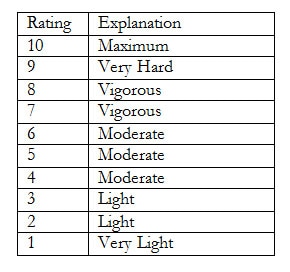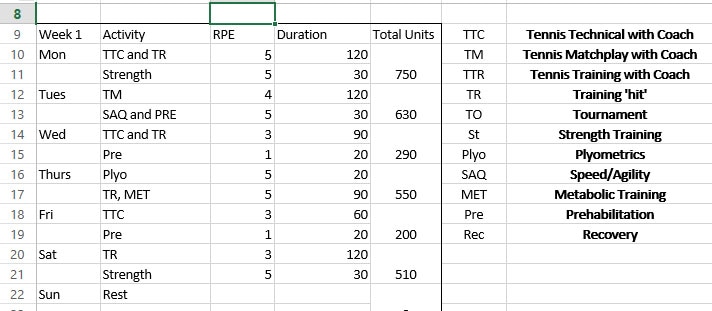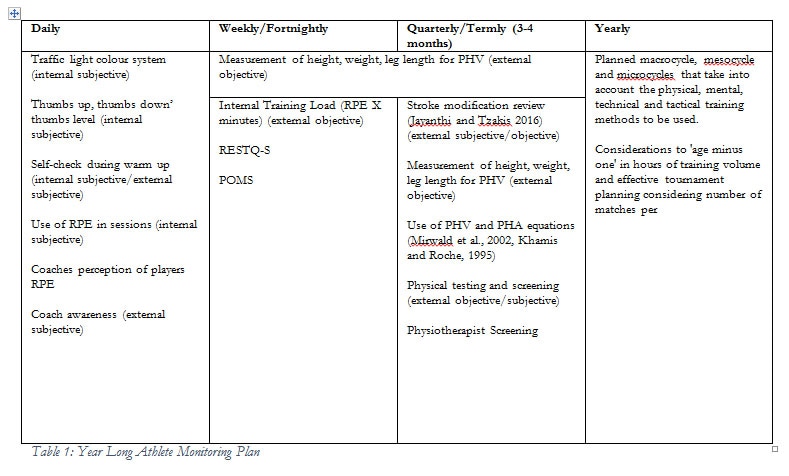Owner of Science in Tennis, Strength and Conditioning Coach Claudio Pistolesi Enterprise
The aim of this group of articles is to provide evidenced based practical considerations on how LTAD can be implemented within tennis clubs, regardless of facilities, number of players or coaches working in the program. Part one emphasised the importance of how motor skill and strength development should work alongside the delivery of tennis coaching. As discussed strength is a key component of motor skills (Lloyd et al., 2016). The second consideration focused on using tennis clubs to promote lifelong health and wellbeing. Strength and conditioning, mental skill training, nutritional education and lifestyle support alongside coaching provides a holistic approach to health and wellbeing of young people. We will look at one more considerations in this part:
Consideration three: monitoring tools can be implemented within programs, with parents and players being educated on their use.
Using monitoring tools considering physical performance, psychosocial wellbeing, growth and maturation should be implemented within long term athletic development programs (Lloyd et al., 2016, iTPA 2012). Factors such as facilities, expertise and cost however may influence the methods used.
Physical Testing
Physical testing allows coaches to determine improvements in physical performance. Testing is likely to focus on areas including speed, agility, strength, power, endurance and movement competency. Procedures and protocols may be adapted to meet the varied ages or the number of players. Testing can occur quarterly or termly, ideally with players tested in a similar environment (such as court surface, temperature and warm up routines). Furthermore, based on the equipment available and expertise testing may vary from the use of a tape measure and stopwatch, to the use of minimal cost Android/iPhone applications (such as My Jump and My Sprint) to the use of high end technology such as Optojump and timing gates. Regardless of what is available if the testing is standardised then the results can provide useful feedback. However not only should the test outcome provide important information. To monitor performance coaches should be aware of movement efficiency. Movement competency can also be assessed, through a check list, looking for important technical components and whether the young athlete demonstrates this (for example as when jumping is the landing balanced). As discussed in Part One, movement competency and body awareness is essential to fundamental movement skills and the development of sport specific skill.
Growth and Maturation Assessments
It is important to remember that young people should not be trained like ‘miniature adults’ with individual differences both in physical and psychosocial development (Lloyd et al., 2016). Growth and maturation should always be an important consideration when coaching junior tennis players. It is an individualised and dynamic process. Rapid increases in growth may put players at risk of increased overuse and traumatic injury pre-and during peak height velocity (PHV) (Sluis et al., 2015). Individual differences in maturation should lead to players program being adapted managing volume and session content (Ochi and Kovacs, 2016). In effect during rapid growth rates players are having to 'relearn skills' and learn about their 'new body'. This may be demonstrated by changes in co-ordination. For example, players spatial orientation may be altered due to changes in limb length and thus perception and contact points on groundstrokes may be different.
With permission from parents and players, coaches should regularly measure players height, leg length and weight and monitor this accordingly. Peak height velocity in girls have been noted to be around 8.3cm/year where with boys this increases to approximately 9.5cm/year (Strandjord and Rome, 2016).
The use of non-invasive measures may also provide coaches with estimation of the age of PHV and the predicated height of adult stature (PHA) (Khamis and Roche, 1995, Mirwald et al.,2002). The equation devised by Mirwald et al., (2002) can provide a predictive measurement of PHV using measurements including height, leg length and weight. This has shown to have an accuracy of ± 6 -12 months but may provide a useful tool for coaches to provide greater insight when PHV may be occur.
The equation is available at:
http://www.kinesiology.usask.ca/growthutility/phv_ui.php.
(University of Saskatchewan, 2017)
Furthermore, awareness of the current maturity of players predicted by PHA may also provide coaches with information about players current growth rates. Khamis and Roche (1995) method takes into account parental heights, height, weight and age of the individual providing a predicted adult height. The method has also been shown to be a reasonable predictor alongside invasive, costlier and medical professional methods measuring skeletal maturity through radiography (Malina et al., 2007). PHV has been shown to occur between 88-96% PHA, with largest gains at around 92% PHA (Cummings et al., 2017). Therefore, having a multitude of data may help provide greater clarity when PHV is occurring. The PHA equation is available at:
http://www.uwmsk.org/stature.html
(University of Washington, 2017)
Therefore, coaches may want to consider the combination of fortnightly to monthly measurements of height, weight and leg length, alongside termly use of equations predicting the age of PHV and PHA. Equations. This will allow more evidenced based considerations when planning training blocks for individual players.
Subjective measure continues to be considered one of the most effective ways to monitor training stress placed upon individual both from chronic (longer term such as over weeks) and acute (one session) training (Saw et al., 2016). Both the Recovery Stress Questionnaire for Athletes (RESTQ-S) and Profile of Mood States (POMS) questionnaire have been shown to be appropriate when working with young athletes (Saw et al., 2016). These questionnaires consider stress, feelings of recovery and mood profile of the individuals. Due to potential time constraints, it would be unrealistic to complete these after each session however coaches, particularly those working with players at high volumes of play, may wish to consider using these fortnightly. Combining this with regular anthropometric measurements may provide a regular monitoring process.
Coaches working alongside strength and conditioning/sport scientists may also wish to consider devising their own subjective questionnaire suiting the needs of their program and players they support. This may consider areas such as feelings of fatigue, muscle soreness, sleep quality, illness, feelings of stress and motivation, social wellbeing (e.g. time with friends/family) and other parameters they may be affecting the individual’s wellbeing such as school work.
Training Loads
Despite having a range of internal (heart rate) and external measures (GPS) that are often used in sport, subjective measures like ratings of perceived exertion (RPE) (Figure One) continues to be used by top practitioners (Gabbett, 2016). Not only is this a cost effective and simple measurement to use it also allows young people to begin to understand how their bodies develop and what training intensities may feel like. The use of arbitrary units through RPE and Time can give coaches a training load:
RPE (of the player during that session) x Duration of Training (minutes) = Load (Figure 2)
Despite little evidence in tennis and particularly with young individual’s, Gabbett (2016) suggested that players were 50-80% more likely to get injured with weekly training loads of 3000-5000 units during preseason. Of course, with young athletes we should consider these numbers with caution and make no generalisations. However, the use of RPE X Time can be an effective way in which to measure training load, allowing training to be planned and adapted very quickly. Although it is important to state when units increased weekly by more than 10% a greater risk of injury was shown. Therefore, training loads should be well planned, managed carefully with regular download weeks.
Technical Elements
A final but obvious consideration is the coaching of effective technique within tennis. Despite there being individual differences in techniques based on anatomical and physiological variations, to maximise performance and reduce injury risk biomechanical principles of stroke production are agreed (Elliott, Reid and Crespo, 2003). However, it may be worth coaches having a 'check list' of effective stroke mechanics which may reduce the risk of injury when coaching junior players. Excellent work has been ongoing focusing on stroke modification following injury (Jayanthi and Tzakis, 2016). Areas of focus on the serve include reducing lumbar (lower back) extension by less than 20° and that knee bend is greater than 10°. Furthermore, focusing on scapular retraction (shoulders pulled back) and effective torso rotation during the loading phase are also important considerations during the serve (Jayanthi and Tzakis, 2016, Kovacs and Ellenbecker, 2011). Reducing excessive ulnar deviation (movement of wrist, little finger side dropping excessively to body) and 'wrist led shots' on groundstrokes may also reduce the risk of injury with additional lower body strength to lunge and load through the kinetic chain of the body (Jayanthi and Tzakis, 2016). Coaches with permission of parents may wish to film players and then using applications such as Coaches Eye or Dartfish analyse areas of technique potentially at the start of every term.
The aim of part two of this blog was to provide an overview of how monitoring tools can be used within tennis programs focusing on one of the pillars from the excellent NSCA Position Statement on LTAD (Llloyd et al., 2016). Tennis coaches are at the forefront with players and parents, because of this they are the 'secret warriors' on emphasising how sport science can be integrated into training not only to benefit performance but more importantly for health and wellbeing. Arguably sport science and tennis coaching go hand in hand and should be considered equally important as a collaboration for LTAD. They should not be separate entities and this where the certification process by the iTPA helps bridge the gap. Not all the suggestions made in this article (summarised in Table One) may be utilised within tennis centres based on the participation levels of players, the available facilities or expertise of the coach. However, as a duty of care to players and to make sure we use tennis as a channel to promote health and wellbeing to young people a robust monitoring system can certainly play its part.
Cumming, S.P., Lloyd, R.S., Oliver,J.L.., Eisenmann, J.C., & Malina, R.M. (2017). Bio-branding in sport: application to competition, talent identification and strength and conditioning of youth athletes. Journal of Strength and Conditioning Research. 39 (2), 34-47.
Elliott, B., Reid, M., & Crespo, M. (Eds.) (2003). Biomechanics of advanced tennis. London: International Tennis Federation.
Gabbett, T. (2016). The training-injury paradox: should athletes be trained harder or smarter? British Journal of Sports Medicine. 50, 273-280
International Tennis Performance Association (2012). Certified Tennis Performance Specialist workbook and study guide. International Tennis Performance Association.
Khmais, H.J.,Roche, A.F. (1995). Predicting adult stature without using skeletal age: The Khamis Roche Approach. Pediatrics, 94 (4), 504-507.
Lloyd, R., Cronin, J.B., Faigenbaum, A.D., Haff G., Howard, R., Kramer., W., …Oliver, J.L.(2016). National Strength and Conditioning Association Position Statement on long-term athletic development. Journal of Strength and Conditioning Research, 30 (6), 1491-1508.
Jayanthi, N., Feller, E., & Smith, A. (2013). Junior competitive tennis: ideal tournament and training recommendations. Journal of Medicine and Science in Tennis. 18 (2), 30-35.
Jayanthi, N. & Tzakis, E. (2016). Return to play tennis on-court stroke modification following injury in junior competitive tennis players. Journal of Medicine and Science in Tennis. 21 (1), 28-35.
Kovacs, M. & Ellenbecker, T. (2011). An 8-Stage Model for Evaluating the Tennis Serve Implications for Performance Enhancement and Injury Prevention. Sports Health. 3 (6), 504-513.
Malina, R.M., Dompier, T.L., Powell, J.W., & Moore, M.T. (2007). Validation of a non-invasive maturity estimate relative to skeletal age in youth football players. Clinical Journal of Sport Medicine. 17 (5), 362-368.
Mirwald, R.L., Baxter Jones, A.D., Bailey, D., Beunen, G.P. (2002). An assessment of maturity from anthropometric measurements. Medicine and Science in Sport and Exercise, 34 (4), 689-694.
Ochi, S.,Kovacs, M. (2016). Periodization and recovery in the young tennis athlete. In A.C.Colvin and J.N.Gladstone (Eds.), The young tennis player, injury prevention and treatment (pp.87-104). Springer.
Saw, A.E., Main, L.C., & Gastin, P.B. (2015). Monitoring the athlete training response: subjective self-reported measures trump commonly used objective measures: a systematic review. British Journal of Sports Medicine. 50, 281-291.
Sluis, A., Elferink-Gemser, M.T., Brink, M.S., Visscher, C. (2015). Important ofpeak height velocity timing in terms of injuries in talented soccer players. International Journal of Sports Medicine, 36 (04), 327-332.
Strendjord, S.E. and Rome, E.S. (2016). Growth and development in the young athlete. In A.C.Colvin and J.N.Gladstone (Eds.), The young tennis player, injury prevention and treatment (pp.87-104). Springer.
University of Saskatchewan. (2017). Prediction of Age of Peak Height Velocity. Retrieved from http://kinesiology.usask.ca/growthutility/phv_ui.php.
University of Washington Radiology Department. (2017). Prediction of Age of Peak Height Velocity. Retrieved from http://uwmsk.org/stature.html.







 RSS Feed
RSS Feed
